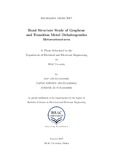Band structure study of graphene and transition metal dichalcogenides heterostructures
Abstract
According to Moore’s Law, it is predicted that the number of transistors –the building
blocks of any modern electronic device– on integrated circuits per square inch
will double every year. However studies show that the limit would be reached within
the next three years as the size of Silicon based transistors, already reduced to a few
tens of nanometers, can no longer be further reduced. This is not the only challenge
for the semiconductor industry. Besides the transistor size, engineers are also not
being able to decrease the minimum voltage required to turn on a device, making
it tough for us to build even low power consuming devices. This has compelled us
to focus on different alternatives. Graphene has turned out to be the wonder material
in the scientific community recently, and its applications are innumerable. It
is only an atomically thick 2 dimensional material with very high electron mobility.
However, the only reason that acts as the barrier to fully utilize the great potential
of this material is its missing band gap. This is when the role of transition metal
dichalcogenides (TMDCs) comes into play, another atomically thick 2 dimensional
set of materials, which, unlike Graphene, has direct band gap but low mobility i.e.
characteristics that can compensate for those missing in Graphene. Scientists have
recently combined Graphene with TMDCs to extract the best possible characteristics
from both the materials in quest for a substitution for traditional Silicon based
transistors in the industry and the results are promising; however, the low current
on/off ratio of such devices is still a challenge that needs to be overcome. In our
thesis we have simulated band structures of Graphene and different TMDCs like
MoS2, MoT e2 etc. Additionally we have simulated band structures of Graphene
interfaced with various TMDCs and also Graphene sandwiched between various
TMDCs. Through literature review, we have also found out the spin orbit coupling
– a phenomenon that allows us to control electricity through orientation of electrons’
polarization rather than the flow of charge – of Graphene and various TMDCs. We
have then graphically analyzed our data and finally proposed that by combining the
electronic band gap and the spin orbit coupling of a material simultaneously in the
future, we may be able to create devices which will be much smaller in size and
run with much lower power than current transistors and simultaneously have a high
current on/off ratio.

